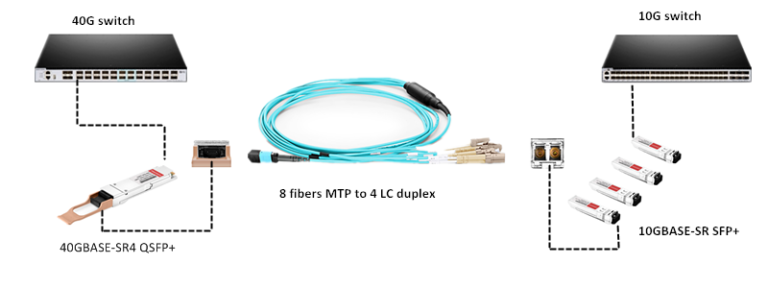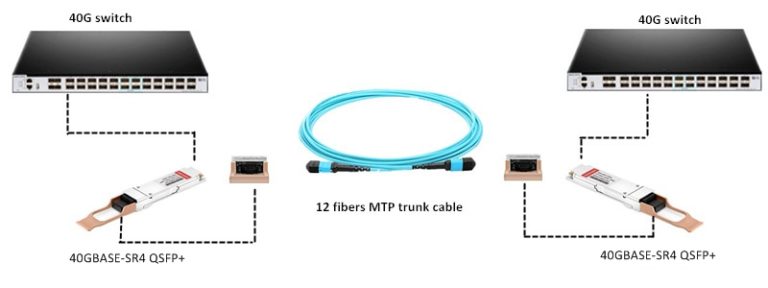The technology behind data center switches, servers and transceivers is changing quickly to accommodate the ever-increasing adoption of cloud computing, along with a growing demand for high-bandwidth applications. As 40G network has been utilized by many data centers, two types of cabling solutions are popular among data center managers—Base-8 connectivity and Base-12 connectivity. How much do you know about these two cabling solutions? This article aims to talk about Base-8 connectivity and Base-12 connectivity for network applications in detail.
Base-8 connectivity builds optical links on increments of the number “eight”. In Base-8 connectivity, 8-fiber MTP trunk cable, 24-fiber or 32-fiber MTP trunk cable can be used to transmit data. Base-8 connectivity provides the most future-ready solution to support high data rate transmission requirements, and the benefits are clear. It allows for 100% fiber utilization for 4-channel (SR4, PSM4, etc.) and 8-channel (SR8, LR8) applications. In addition, it eliminates conversion modules which can reduce link attenuation by 50% and enables longer parallel link distances. Base-8 connectivity will be the cleanest path from 10G to 40G and beyond regardless of protocol.
Many data centers are in the process of 10G to 40G migration, and Base-8 connectivity can provide a simple and reliable solution—using the MTP/MPO breakout cable. As shown in the following picture, one 40GBASE-SR4 QSFP+ transceiver is plugged in the QSFP+ interface on the 40G switch on one side, while four 10GBASE-SR SFP+ transceivers are plugged in the SFP+ interfaces on the 10G switch on the other side. Then the MTP to LC breakout cable connects the 40GBASE-SR4 QSFP+ transceiver with the four 10GBASE-SR SFP+ transceivers. Finally, the data can be transmitted from 10G switch to 40G switch through the MTP to LC breakout cable smoothly.

Base-12 connectivity makes use of fiber optical links based on increments of 12 fibers. And 12-fiber or 24-fiber MTP connector assemblies are usually used to accomplish the links, such as 12-fiber or 24-fiber MTP trunk cable. When using Base-12 connectivity, a larger number of fibers can be installed quickly because the 12-fiber or 24-fiber MTP connector can provide higher fiber cabling density. However, in Base-12 connectivity, four fibers for transmit and four fibers for receive, leaving four fibers unused per connection. In spite of this, Base-12 connectivity in some cases may still be more cost-effective which can meet the newer 40G/100G standard format.
For 40G network, 12-fiber MTP trunk cable can provide the simplest way. As shown in the following picture, two 40GBASE-SR4 QSFP+ transceivers are separately plugged in the QSFP+ interface on the 40G switch on each side. Then the 12-fiber MTP trunk cable connects the two 40GBASE-SR4 QSFP+ transceivers. Finally, the 40G optical link is accomplished.

Both Base-8 connectivity and Base-12 connectivity have their own benefits. Though Base-8 can realize 100% fiber utilization in cabling system, it is not an universal solution. While Base-12 connectivity in some cases may still be more cost-effective. As for which one to choose, it depends on the requirements of the network deployment. I hope this article can help you have a better understanding of this two cabling solutions.